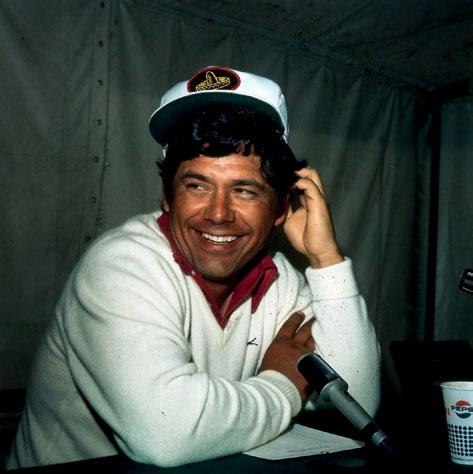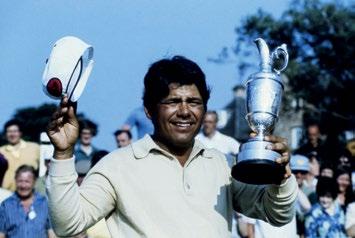
10 minute read
Golf
Golf Supermex cards 80
Dermot Gilleece on the legend that is Lee Trevino
Lee Trevino was 80 on December 1st. The milestone was notable, not least for the winner of six major championships, but for the first American golfer in modern times to have achieved such prominence without coming through the college system.
Trevino was born into humble circumstances in Dallas, Texas. And he never forgot it, even after his prodigious skills had delivered 70 tournament victories and more than $20 million in tournament earnings. Nor was there ever a hint of envy at his more fortunate peers. Indeed his progress through the game was marked by an irrepressible sense of fun, which has invariably delighted his many admirers.
I first became aware of it during the 1984 Open Championship at St Andrews where he came into the media centre for interview, early in the week. It being a beautiful summer’s day, he was asked at the end of press grilling what he planned to do for the remainder of the afternoon. ‘I’m going down on the beach to brush up my tan,’ came the mischievous reply from this dark-skinned product of Mexican forebears.
He never lost the gift of keeping his fans amused. Like on the first tee where he was liable to throw his golf ball into a bucket of water while loudly urging it to ‘get plenty to drink now, so you won't be thirsty on the course.’ Then, as if he had betrayed a confidence, he would whisper: ‘You know, I used to soak them in the commode’.
48 Senior Times l January - February 2019 l www.seniortimes.ie Trevino was born into humble circumstances in Dallas, Texas. And he never forgot it, even after his prodigious skills had delivered 70 tournament victories and more than $20 million in tournament earnings.

June 1967 marked his emergence as one of the all-time great talents of the game. Among other things, a fifth-place finish behind Jack Nicklaus in the US Open at Baltusrol, meant there would be no return to cleaning clubs, polishing shoes and picking up range balls as a general dogs body back in El Paso, Texas.
I hope that, one day, my grandchildren will ask, “What WAS cancer?”


You can help make cancer a thing of the past by leaving a gift to the Irish Cancer Society in your Will.
Contact Aoife McDarby at 01-2316629, email amcdarby@irishcancer.ie or speak to your solicitor. www.cancer.ie/legacy

After encountering Trevino in an epic 54-hole battle, Raymond Floyd told colleagues: ‘Boys, there’s a little Mexican kid out in El Paso and when he comes out here, you’ll have to make room for him.’

The man who would come to be known as Supermex, visited these shores for the first time three years later, for the Alcan Golfer of the Year Championship at Portmarnock. And curiously, he struggled in equinoctial winds in an event dominated by Australia’s Bruce Devlin, the so-called Thin Man of the tour.
Though he missed only three greens while guiding the bigger, American ball, through fierce winds on the opening day, Trevino complained: ‘Any time a guy hits that many greens in this kind of wind, he deserves better than a 72.’
Before joining America’s PGA Tour, he was assistant professional at Horizon Hills GC. The bulk of his earnings came from money matches throughout the state of Texas of which a particularly notable encounter was against a promising tour player named Raymond Floyd.
It was arranged by golf enthusiast, Martin Lettunich, a wealthy cotton-farmer who clearly enjoyed the action. We’re told that when Floyd drove up to Horizon Hills in his white Cadillac, Trevino rushed out of the pro shop to greet him, asking politely if he needed his clubs cleaned. Pleased with all the attention, the visitor proceeded to the locker-room where the helpful menial unpacked his clubs and polished his shoes. ‘Who am I playing?’ asked Floyd. ‘You’re looking at him,’ replied the pudgy, 5ft 7ins figure standing before him. Floyd couldn’t resist saying: ‘You mean they bet on you!’
Then, on being asked by a local whether he would like to check out the course, Floyd responded: ‘Hell no. I’m playing this locker-room guy. I don’t need to look at no course.’
The match took the form of 54 holes over three days. On the first day, Floyd shot 66, Trevino 65. On day two, Floyd shot another 66 but Trevino replied with a 64. Eventually, it all rested on the final hole the following day when Floyd scored an eagle to win by a stroke.
As he drove away, the future winner of four major titles starting with the PGA Championship before that decade was out, leaned out of the Cadillac’s window with the parting shot: ‘I’ll see you all later. There’s easier games than this on tour.’ And by way of emphasising the point, he subsequently told tour colleagues: ‘Boys, there’s a little Mexican kid out in El Paso and when he comes out here, you’ll have to make room for him.’
50 Senior Times l January - February 2019 l www.seniortimes.ie Lee Trevino with the British Open, one of 70 tournament victories
in his wake. During the final round, they had gathered at the fifth tee relatively close to the clubhouse when their quarry appeared, wearing a faded green shirt, baggy black trousers, black shoes and a black, baseball-type hat.
Sommers wrote: ‘He stood up to the ball with an open stance, his left foot drawn back from the line of flight, and took the club back on a flat, awkward plane. But when he moved through the ball, his club head followed the line of flight for what seemed an exaggerated distance. He had the longest extension through the ball since [Ben] Hogan.’
Over the remainder of 1967, the 27-year-old won more than $27,000 and was voted Rookie of the Year. And the following June at Oak Hill CC, he picked up $30,000 as winner of the US Open, four strokes clear of Nicklaus in second place. The pudgy kid with the coal-black hair, nutbrown skin and white, even teeth, had well and truly arrived.
Though I had caught fleeting glimpses of Trevino at Portmarnock in 1970, his appearance in the 1985 Irish Open at Royal Dublin was far more rewarding. That was when enduring admiration for Christy O’Connor was evident when he enthused: ‘Christy’s swing flows like fine wine.’ In the event, Trevino overcame an opening 78 to be tied 34th behind his great compadre, Seve Ballesteros.
Two years later, Trevino was at Baltray for The Legends Cup in which, for once, the participants were worthy of the title. It was Monday July 20th 1987, the day after Nick Faldo stunned the golfing world by winning the Open Championship at Muirfield with 18 straight pars.
Trevino and Arnold Palmer lost a four-ball match against the Irish pairing of Des Smyth and Himself, not that the outcome mattered. ‘Lee gave a clinic on the fourth tee, which had a large, local crowd enthralled,’ recalled Barry Reddan, the Co Louth captain that year. ‘Knowing that he was famous as a fader of the ball, they insisted that he hit a few draws, which he did to perfection. It was a great occasion.’
My last meeting with Trevino was at the actual Legends Tournament in Savannah, in 2010. I remembered a tribute he had paid 20 years previously to a very close golfing friend. ‘Every generation or so, there emerges a golfer who is a little bit better than anybody else,’ he said. ‘I believe Ballesteros is one of them. On a golf course he's got everything. I mean everything: touch, power, know-how, courage and charisma.’ Now, Trevino was recalling a very different Seve. ‘When he went back home [from the US] and there was a tragedy involving his girlfriend, I then heard he had a brain tumour,’ he said. ‘I lost my mother-in-law with a brain tumour and my wife and I were very concerned because that's the one place where cancer is very difficult to overcome. ‘But I'll tell you one thing about Seve. He's held on a helluva lot longer than most people with that type of cancer. It tells you what type of a fighter he is. He was always a magician on the golf course.’ On May 7th of the following year, Seve departed to verdant fairways in the great beyond.
Getting personal
The personal ads that appear in newspapers and magazines , mostly regional ones, are a rich repository of stories as journalist, Brian O'Connell, discovered when he was starting out in his career. Ennis-born but Cork-based O'Connell, a reporter on 'Today with Sean O'Rourke' on RTE Radio One, has written a book entitled 'The Personals - The human stories behind the small ads.'
O'Connell's interest in the personal ads was sparked when he was in need of quirky human interest stories to pitch to his editors. He has now parlayed his quest into a book. Highly entertaining and sometimes poignant, it deals with ads ranging from one for a pair of breeding monkey for sale (with or without cage) to a man selling a nineteenth century hearse. Throw into the mix over fifty pages dedicated to the heartbreaking stories behind ads declaring engagement rings and wedding dresses for sale and you've got all human (and a bit of animal) life here.
Sources of personal ads include the Echo newspaper in Cork, the lonely hearts column in Ireland's Own and the classified section in the Irish Farmer's Journal.
Despite our digital age, "quite a number of mostly regional newspapers have a commitment to publishing personal ads," says O'Connell. He also scours the online ads on the likes of DoneDeal, Adverts.ie and Gumtree.
"The most interesting ones for me tend to be from print (publications.) I decided to use the ads as a doorway into contemporary Irish life. My book goes back to about seven years ago up to today. Some of the unusual stories involved people living quite isolated lives. They came through print. Obviously, these people wouldn't have access to technology and wouldn't be using the internet. It was really fascinating to spend time with these people."
Getting people to open up was Brian's challenge. In some cases, he doesn't give the names of the people he interviewed as the subject matter was too delicate. Some people, he says, were delighted to be able to talk to him. Others thought he was a scam merchant. But over time, he built up ways of contacting people and winning their trust.
Colette Sheridan talks to Brian O’Connell who has recently published a book based on the human interest stories that are personal ads. in newspapers and magazines.
Brian O’Connell

Senior Times l January - February 2020 l www.seniortimes.ie 51 and wedding rings for sale agreed to meet me. She hadn't told many people her story. It was too raw. Essentially, she met somebody who lives abroad. It was a kind of whirlwind romance with a lot of skyping each other. They got married in his home country in the Middle East. She paid for the application for his visa to Ireland which cost several thousand Euros. He didn't get a visa. Lo and behold, two weeks later, he got married to someone else. So she was left on the line with the cost of the visa application, the solicitor's bills and the rings which she bought in Dubai. They're fabulous looking rings. She was selling them to clear her VISA bill. She said it was like something you'd see on Jeremy Kyle. She couldn't believe it happened to her. She's an intelligent, professional woman who said she couldn't believe she fell for this. She had travelled a bit of a journey herself in terms of her own development. She had come to the realisation that she prefers being open to the idea of love even though what happened to her was an absolute disaster. She didn't want to be somebody who was closed. She was trying not to let it affect her and getting rid of the rings was the first step for her."









